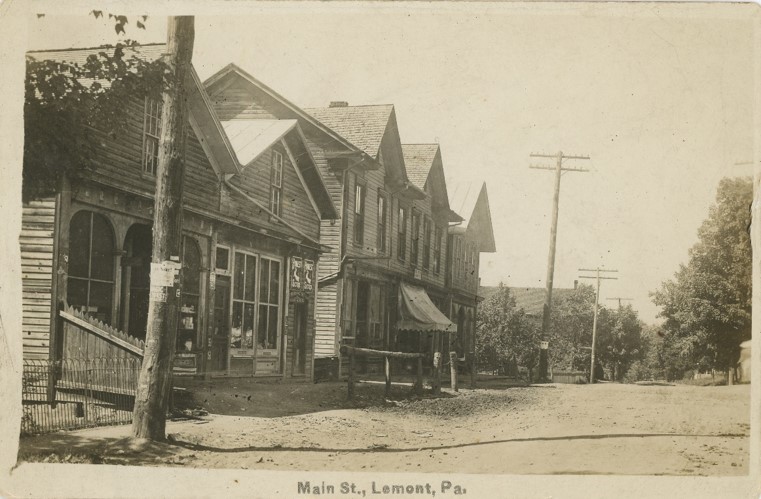Lemont is a historic village in College Township nestled at the base of Nittany Mountain. Traditionally known as “The End of the Mountain,” it slowly grew as a settlement in the early 1800s as an important crossroads connecting the Nittany and Penns valleys. The village was a stagecoach stop on the Bellefonte to Boalsburg turnpike.
Lemont was heavily influenced by the flourishing iron industry – particularly at nearby Centre Furnace – and by farming. Many of the early residents settled in Lemont to build large farms on the fertile lands of the Nittany Valley. The village borders Spring Creek, which connects it to the nearby villages of Oak Hall and Boalsburg to the south and Houserville and Rock Forges to the north, all then in Harris Township before the 1875 creation of College Township.
The land on which Lemont stands was part of a 1,200-acre tract settled by David Whitehill in 1789. Among the most notable early settlers was Christian Dale, who moved there in 1790 and later established a gristmill and sawmill. The land that would constitute the village was purchased by James Irvin of Oak Hall, the partner with Moses Thompson of Centre Furnace.
Thompson bought the property in 1869, and the next year he laid out the village. In 1885, Thompson’s son, John I. Thompson, gave Lemont its name [French for “The Mountain”].

As a busy crossroads village, Lemont became an attractive location for businesses and residents. A general store, hotel, bank, and blacksmith shop opened. Large homes, many in the popular Victorian style, were built along Pike Street. The Spring Creek Presbyterian Church also was founded.
The Pennsylvania Railroad finally connected its Lewisburg & Tyrone Railroad (L&T) line through to Bellefonte from the east in 1885, which provided Lemont with twice-daily passenger and freight rail service. Although plans to extend the L&T line from Lemont through State College to Scotia and Tyrone, also served by the Pennsylvania, never materialized, many Penn State students and faculty departed at the village’s train station and took buggies to the campus.
Taking advantage of the railroad, John Thompson built a grain elevator and coal sheds along the train tracks on Mountain Road, which today is Mount Nittany Road. The elevator stored grain and the sheds stored coal from incoming trains. Today’s nearby Hanson Aggregates limestone quarry represents another aspect of Lemont’s long association with the iron industry, the mining of high quality limestone, initially for iron manufacturing, but more recently for other industrial and construction uses.
By the end of the 1920s, Lemont was declining as a commercial and transportation center. Passenger service at the Lemont station had ended, but freight service continued through World War II. The train station closed after the decline of freight service. It later was demolished and rebuilt for offices and shops.
State Route 26, connecting Bellefonte and State College, once ran through Lemont. Over the years, there were many renovations and changes to the road, which included widening it to four lanes and, in 1948, bypassing the village altogether.

Lemont had one of the earliest schools in Centre County, beginning in 1800, and primary school classes continued to be taught in various homes and buildings over the years. The Lemont Elementary School, which overlooks the village, opened in 1939. A new elementary school was built in Houserville by the State College Area School District to replace it, and the Lemont school building has been used for private educational purposes since 2017.
After World War II, Lemont increasingly became a bedroom community for State College and Penn State. New neighborhoods and homes were built across Spring Creek, which bisects the village. Today there is little separation between Lemont and surrounding villages. Lemont’s population in 2010 was 2,270 as a discrete village, while College Township’s population has grown dramatically from 2,275 in 1950 to 9,521 in 2010.
The Art Alliance of Central Pennsylvania has been a mainstay of Lemont for decades. Founded in 1968, the Art Alliance is housed in the old band hall that was formerly the home of the Lemont Band, a popular musical ensemble for decades. Today, it provides space for both classes and other instructional activities as well as a gallery where the work of local artists is shown and sold.
The Lemont Village Association was created in 1979 to preserve the historic character of the village. The next year the association fought a proposal by the U.S. Postal Service to move Lemont’s post office from its tiny Pike Street building to a new facility on College Avenue. Working with College Township, the association helped acquire the old railroad yard where the current post office on Mary Street was built in 1981.
In 1994, the association purchased the Thompson grain elevator for $55,000. Thanks to extensive fundraising and many volunteer hours restoring the elevator, it remains one of the oldest wooden grain elevators in the county. The grain elevator is a center of activity for the village, hosting concerts, markets, weddings, and other events and is commemorated by a Pennsylvania state historical marker.
The Lemont Historic District, which includes eighty-one principal structures, was added to the National Register of Historic Places in 1979.
Jonathan McVerry
Sources:
National Register of Historic Places, Lemont Historic District Nomination Form, 1979.
Linn, John B. History of Centre, and Clinton Counties. Philadelphia: Louis H. Everts, 1883.
Frank H. Glenn, Ilene Glenn, Louise K. Mayes and Willard F. Mullen, “A History of College Township Before and After 1875.”
Manns, Valerie. “Granary helps unlock Lemont History,” Centre Daily Times, April 14, 1998.
Rosenblum, Chris. “It takes a Village, Hard work, good neighbors help Lemont recapture Victorian charm,” Centre Daily Times, June 22, 2005.
First Published: February 3, 2022
Last Modified: April 28, 2025
